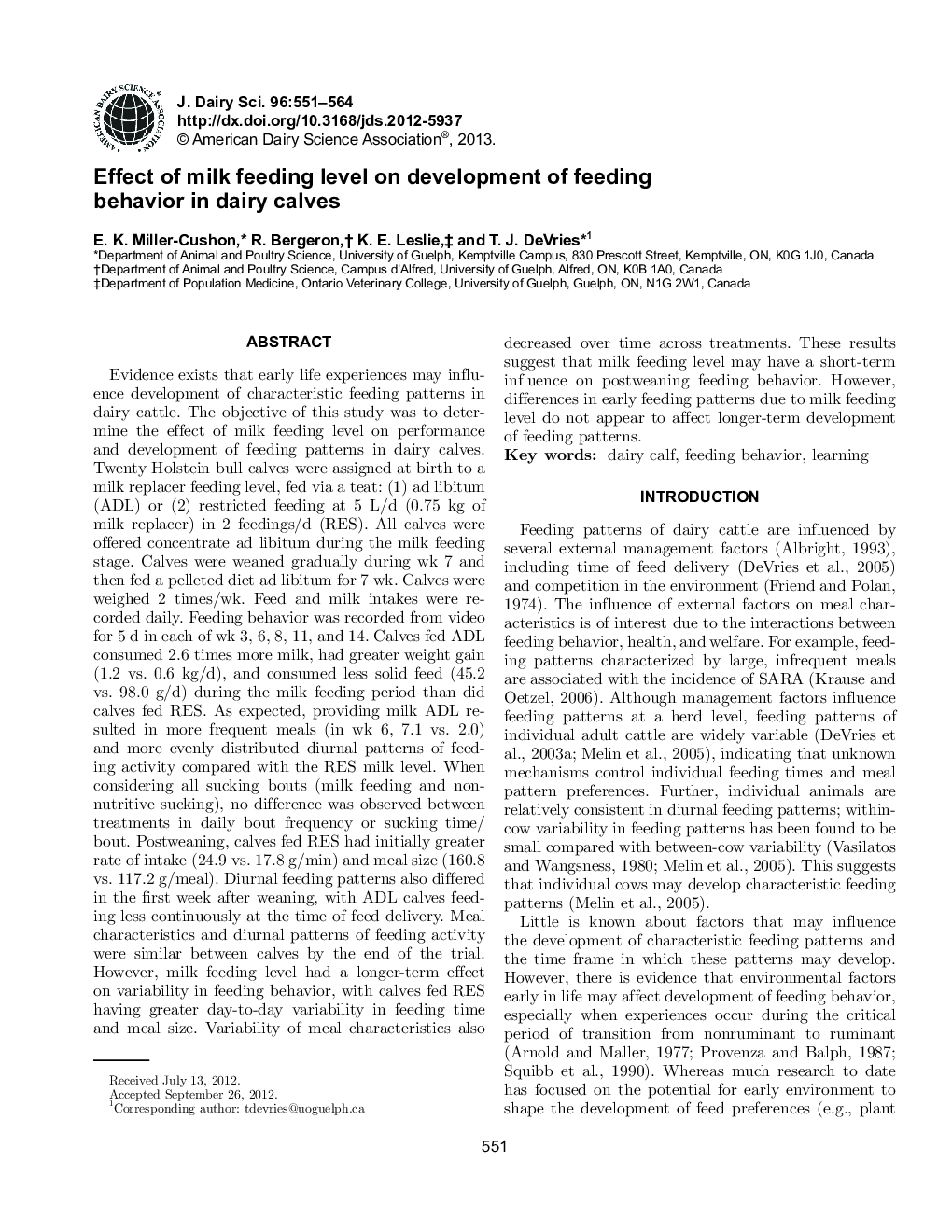| کد مقاله | کد نشریه | سال انتشار | مقاله انگلیسی | نسخه تمام متن |
|---|---|---|---|---|
| 10980620 | 1108071 | 2013 | 14 صفحه PDF | دانلود رایگان |
عنوان انگلیسی مقاله ISI
Effect of milk feeding level on development of feeding behavior in dairy calves
ترجمه فارسی عنوان
تأثیر سطح شیر تغذیه بر توسعه تغذیه در گوساله های شیری
دانلود مقاله + سفارش ترجمه
دانلود مقاله ISI انگلیسی
رایگان برای ایرانیان
کلمات کلیدی
گوساله لبنی رفتار تغذیه ای یادگیری،
موضوعات مرتبط
علوم زیستی و بیوفناوری
علوم کشاورزی و بیولوژیک
علوم دامی و جانورشناسی
چکیده انگلیسی
Evidence exists that early life experiences may influence development of characteristic feeding patterns in dairy cattle. The objective of this study was to determine the effect of milk feeding level on performance and development of feeding patterns in dairy calves. Twenty Holstein bull calves were assigned at birth to a milk replacer feeding level, fed via a teat: (1) ad libitum (ADL) or (2) restricted feeding at 5Â L/d (0.75Â kg of milk replacer) in 2 feedings/d (RES). All calves were offered concentrate ad libitum during the milk feeding stage. Calves were weaned gradually during wk 7 and then fed a pelleted diet ad libitum for 7 wk. Calves were weighed 2 times/wk. Feed and milk intakes were recorded daily. Feeding behavior was recorded from video for 5Â d in each of wk 3, 6, 8, 11, and 14. Calves fed ADL consumed 2.6 times more milk, had greater weight gain (1.2 vs. 0.6Â kg/d), and consumed less solid feed (45.2 vs. 98.0Â g/d) during the milk feeding period than did calves fed RES. As expected, providing milk ADL resulted in more frequent meals (in wk 6, 7.1 vs. 2.0) and more evenly distributed diurnal patterns of feeding activity compared with the RES milk level. When considering all sucking bouts (milk feeding and nonnutritive sucking), no difference was observed between treatments in daily bout frequency or sucking time/bout. Postweaning, calves fed RES had initially greater rate of intake (24.9 vs. 17.8Â g/min) and meal size (160.8 vs. 117.2Â g/meal). Diurnal feeding patterns also differed in the first week after weaning, with ADL calves feeding less continuously at the time of feed delivery. Meal characteristics and diurnal patterns of feeding activity were similar between calves by the end of the trial. However, milk feeding level had a longer-term effect on variability in feeding behavior, with calves fed RES having greater day-to-day variability in feeding time and meal size. Variability of meal characteristics also decreased over time across treatments. These results suggest that milk feeding level may have a short-term influence on postweaning feeding behavior. However, differences in early feeding patterns due to milk feeding level do not appear to affect longer-term development of feeding patterns.
ناشر
Database: Elsevier - ScienceDirect (ساینس دایرکت)
Journal: Journal of Dairy Science - Volume 96, Issue 1, January 2013, Pages 551-564
Journal: Journal of Dairy Science - Volume 96, Issue 1, January 2013, Pages 551-564
نویسندگان
E.K. Miller-Cushon, R. Bergeron, K.E. Leslie, T.J. DeVries,
